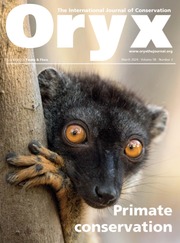To address pressing issues in biodiversity conservation, researchers may require access to biological samples that are difficult to collect because of the invasive nature of particular sampling techniques, the threatened or protected status of target species, the difficulty of obtaining relevant permits, or other logistical, financial or ethical concerns. Biobanks and zoological collections may provide a useful alternative source of sample materials.
In January 2025, the world's oldest scientific zoological society, the Zoological Society of London (ZSL), launched a biological library, making its biological collections accessible to the wider conservation community. The ZSL Biobank currently holds > 1,200 dry and > 50,000 frozen specimens, which will be made available to conservation researchers and educators through ongoing digitization efforts. Dry collections include taxidermy, skins, furs, skulls, shells, accessories and traditional medicines, predominantly acquired through private donations and wildlife crime seizures in the UK. Frozen collections include swabs, bodily fluids, postmortem tissues and entire carcasses, and originate predominantly from routine veterinary collections at British zoos and ZSL Institute of Zoology research projects. Specimens cover a wide range of British (native and non-native) and international species, including both captive and wild individuals.
These collections are managed in accordance with the Nagoya Protocol (Access and Benefits Sharing), to ensure fair and equitable sharing of benefits arising from the utilization of genetic resources. Dry and frozen specimens have now been made available for destructive and non-destructive sampling by researchers, as well as the loaning of some items for educational use. A further wet collection will be made available in due course.
The collections in the ZSL Biobank have previously supported a range of research activities, including comparative neuroimaging of carnivoran brains (Boch et al., 2024, eLife, 13, RP100851), providing insights on cancer and ageing through analysis of somatic mutation rates (Cagan et al., 2022, Nature, 604, 517–524), and addressing questions in species taxonomy (Marr et al., 2024, Evolutionary Journal of the Linnean Society, 3, kzae007). The collections would also be suitable for supporting research in wildlife genetics, animal health, wildlife crime and forensics, and historical ecology.
Applications for destructive or non-destructive samples for research purposes, and loans for educational purposes, are now being accepted. Expressions of interest should be submitted to biobank@zsl.org. If the ZSL Biobank is able to help with a request, an application form will be provided and should be completed and returned. The ZSL Biobank is also accepting sample donations from legacy collections.


